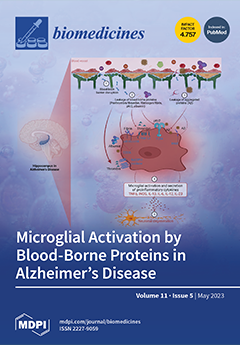Idiopathic pulmonary fibrosis (IPF) is a chronic, progressive fibrotic lung disorder, ultimately leading to respiratory failure and death. Despite great research advances in understanding the mechanisms underlying the disease, its diagnosis, and its treatment, IPF still remains idiopathic without known biological or histological
[...] Read more.
Idiopathic pulmonary fibrosis (IPF) is a chronic, progressive fibrotic lung disorder, ultimately leading to respiratory failure and death. Despite great research advances in understanding the mechanisms underlying the disease, its diagnosis, and its treatment, IPF still remains idiopathic without known biological or histological markers able to predict disease progression or response to treatment. The histologic hallmark of IPF is usual interstitial pneumonia (UIP), with its intricate architectural distortion and temporal inhomogeneity. We hypothesize that normal lung alveolar architecture can be compared to fractals, such as the Pythagoras tree with its fractal dimension (
Df), and every pathological insult, distorting the normal lung structure, could result in
Df variations. In this study, we aimed to assess the UIP histologic fractal dimension in relationship to other morphometric parameters in newly diagnosed IPF patients and its possible role in the prognostic stratification of the disease. Clinical data and lung tissue specimens were obtained from twelve patients with IPF, twelve patients with non-specific interstitial pneumonia (NSIP), and age-matched “healthy” control lung tissue from patients undergoing lung surgery for other causes. Histology and histomorphometry were performed to evaluate
Df and lacunarity measures, using the box counting method on the FracLac ImageJ plugin. The results showed that
Df was significantly higher in IPF patients compared to controls and fibrotic NSIP patients, indicating greater architectural distortion in IPF. Additionally, high
Df values were associated with higher fibroblastic foci density and worse prognostic outcomes in IPF, suggesting that
Df may serve as a potential novel prognostic marker for IPF. The scalability of
Df measurements was demonstrated through repeated measurements on smaller portions from the same surgical biopsies, which were selected to mimic a cryobiopsy. Our study provides further evidence to support the use of fractal morphometry as a tool for quantifying and determining lung tissue remodeling in IPF, and we demonstrated a significant correlation between histological and radiological
Df in UIP pattern, as well as a significant association between
Df and FF density. Furthermore, our study demonstrates the scalability and self-similarity of
Df measurements across different biopsy types, including surgical and smaller specimens.
Full article






